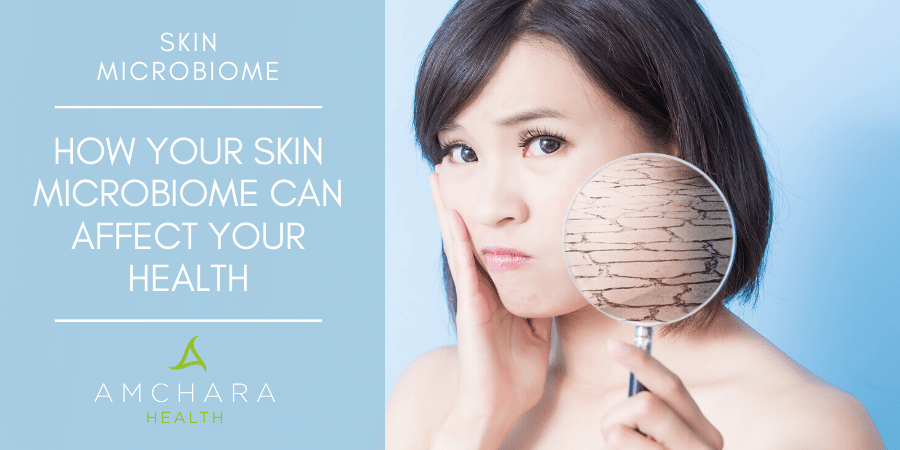Topics Covered in this article:
You may be aware that you have a population of bacteria living inside your gut, called your microbiome. Science is now discovering there is also a collection of bacteria resident on your skin. At this moment, millions of bacteria are living on every part of your skin’s surface.
We always take an evidence-based approach and in this article we’ll bring you some fascinating discoveries about your skin microbiome and how it can affect your health.
Bacteria on your skin
You have around 1.8 square metres of skin, making it the largest organ in your body. It’s a strong physical barrier forming an interface between what’s inside you and events happening outside.
Your skin needs to be hostile to intruders and resist penetration by disease-causing microbes and toxins, whilst also retaining nutrients and moisture inside the body.
A huge number of different microorganisms live happily both on the skin’s surface and within the deeper layers of the skin, including bacteria, viruses and fungi, and even minuscule mites. Most of the time you won’t be aware of their existence of these bugs, many of which are beneficial or at least harmless.
It’s estimated there are hundreds of species of bacteria which can colonise the skin, and each species consists of many strains.
Functions of the skin microbiome
We have learnt a great deal about the important role played by the gut microbiome in health and disease. Bacteria in the gut interact with the immune system and send out messenger molecules all around the body.
We’re now discovering the skin microbiome influences the health of your skin in similar ways.
The bacteria making your skin their home communicate with your immune system by educating your T-cells. These are the cells which learn to distinguish invaders from friendly substances (1). It’s believed a healthy skin microbiome may reduce the likelihood of developing allergies and autoimmune diseases.
As well as protecting you against infection, by crowding out pathogenic bacteria and producing molecules which inhibit colonisation of the skin by other harmful microbes, your skin microbiome also creates a beneficial pH for the growth of other friendly bacteria. The natural pH of the skin is slightly acidic, and many pathogens don’t thrive in an acidic environment.
Bacteria also help to control skin inflammation, assist wound healing and may even provide protection from skin cancer (2).
Your individual skin microbiome
Just as a wide range of bacteria living in your gut supports whole-body health, a diverse range of bacterial species is important for a healthy skin. However, your skin microbiome is unique to you – it’s your own personal bacterial fingerprint, and studies have shown bacteria vary greatly between different individuals.
The skin’s microbiome comprises similar types of bacteria to those found in the gut bacteria and the oral microbiota in the mouth, but the relative proportions of bacterial species differ. As in the gut, Bifidobacterium and Lactobacillus species can be found on the skin, but they’re less numerous than in the digestive system.
Bacteria live not only on and within the skin but also in the sweat glands and hair follicles.
The composition of species depends on whereabouts on the skin they are residing as well as your age, gender, and even the environment in which you live.
Your skin provides diverse habitats. Some skin is thicker than other areas, some has natural folds, and different areas of skin have varying densities of hair follicles, sweat glands and oil glands.
Different strains of bacteria prefer distinct environments. Sweat glands, sebaceous glands and hair follicles are associated with their own unique bacterial balance. Areas of the skin with a high density of sebaceous glands, such as the chest and face, encourage the growth of bacteria which can utilise fats, such as a bacteria called Propionibacterium.
Folds of the skin such as the underarm are warmer and more humid, which encourages the growth of different organisms. These bacteria utilise sweat and it’s this process which causes body odour.
A developing foetus doesn’t possess a skin microbiome, in the same way as it lacks any gut bacteria. Colonisation starts during birth and the ratio of species changes as you grow older.
During puberty, sebum secretion increases and bacteria alter accordingly. Hormonal differences between males and females account for some of the microbial differences seen between the genders. So the skin microbiome of a teenage boy will be different to one of a post-menopausal women.
Other influencing factors include choice of clothing fabric, antibiotic usage, exposure to UV light and even occupation. Use of soaps, cosmetics and hygiene products and how often you wash your skin can also affect microbial balance. This is because these habits are able to change the conditions on the surface of the skin, such as the skin’s pH.
Unbalanced bacteria
When bacteria become unbalanced, skin disorders or infections can be the result.
Science has discovered skin diseases such as acne, eczema, psoriasis and dandruff are characterised by specific compositions of bacteria within the skin microbiome.
A strain of bacteria known as Cutibacterium acnes can become unbalanced and, as its name suggests, is associated with acne.
Another type of bacteria, Staphylococcus aureus, is more plentiful in cases of atopic dermatitis, with the severity of the condition correlating with the amount of this species of bacteria.
People with eczema are often lacking beneficial bacteria in the skin’s microbiome and tend to have higher than average amounts of bacteria called Propionibacterium acnes.
In the case of psoriasis, higher proportions of a type of bacteria called Firmicutes were observed in areas of inflammation, when compared to healthy skin (3).
It seems the skin microbiome may be capable of relocating from person to person. Researchers developed techniques to transfer skin bacteria from the skin of one person to another and discovered over time the recipient’s microbiome became more similar to that of the donor. The bacteria were able to colonise the skin despite the participants showering as usual as well as practicing sports.
The tendency for bacteria to colonise a recipient depends on the composition of both the donor and recipient microbiome (4). Science is already using this type of bacterial transfer to improve the gut microbiome.
How to protect your skin microbiome
Paying attention to the health of your skin’s microbiome may help to improve your skin health.
Our lifestyles have changed dramatically over the last hundred years. We now take hot showers or baths every day, wash in chlorinated water which kills bacteria, and use antibacterial soap, deodorants and hand cleansers.
Any product we put on our skin needs to be preserved to prevent it decomposing over time, and this often means adding antimicrobial agents which can impact the skin’s bacteria. Use of antimicrobial hand sanitisers is not surprisingly associated with an imbalanced skin microbiome. Even soap is naturally alkalising, albeit temporarily – this is how it removes dirt and microbes.
To protect your skin’s microbiome, minimise your use of antibacterial hand sanitisers and soaps. Switch to beauty products containing natural ingredients, which are kinder to your skin’s bacteria.
The skin’s bacterial balance can also be compromised by your food choices and the health of your gut microbiome. Science has shown gut health is closely connected with skin health.
Supporting your gut bacterial balance by avoiding sugar, processed foods and alcohol, and eating plenty of microbiome nourishing fresh vegetables, fruit and pulses can help keep your gut bacteria healthy and happy.
Takeaway
Although historically there has been a tendency to believe that bacteria are harmful and should be eradicated at all costs, when it comes to skin health this is not the case, and reliance on antibacterial skin and cleansing products may be disrupting the protective skin microbiome.
If you are concerned about your skin health, a consultation with an Amchara Personalised Health practitioner can help discover how your microbiome, food choices and lifestyle may be impacting upon your skin.
This doesn’t need to be the end of the article.
Did you find this article useful?
Please share your thoughts in the comments.
Read this next:




